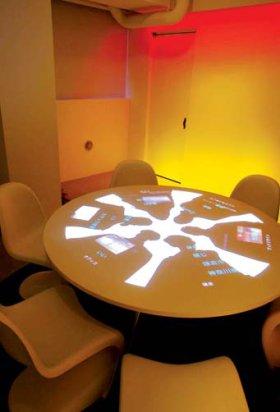Technology: Brainstorming the Future

By Ed Thompson
The future of office spaces could well be creative environments that stimulate the senses.
In the office of the future, smart-rooms that automatically respond to voice, motion, and other cues promise to boost productivity and encourage new forms of communication. For IT solutions provider Kayac Co., Ltd., that future is now. The company has teamed up with digital communications researchers from the Keio University Inakage Lab to develop a speech recognition-capable brainstorming room designed to enhance group creativity by monitoring the conversation of its occupants, identifying keywords in their speech, and feeding them a stream of related images and text retrieved from online search engines.
The prototype system, named “Kageroi,” currently occupies a corner room at Kayac headquarters in Kamakura. At first glance, the brainstorming room looks like an ordinary meeting space furnished with a round table for six. But the difference becomes clear after the server is fired up, when an LED lighting system bathes the room in mood-altering color. Once Kageroi is booted and ready to roll, a ceiling-mounted projector displays a static image of six human-shaped shadows on the table.
 Images and text are displayed on a table inside the Kageroi brainstorming room at Kayac headquarters.
Images and text are displayed on a table inside the Kageroi brainstorming room at Kayac headquarters.
PHOTO COURTESY OF Kayac Co., Ltd.
Kageroi’s primary function is to automatically display a stream of data on the table during a brainstorming session. As people speak, wireless microphones relay the conversation to the server. Speech recognition software identifies keywords, which are then converted to text and fed to a small selection of search engines. When the search results are returned, the images are processed and the text data is broken into fragments before the ceiling-mounted projector beams them onto the person’s shadow on the table. For a brief moment, the images and disembodied pieces of text drift slowly in seemingly random directions across the table before fading from view. The result is an ever-shifting collage of visual data that can spark new trains of thought or take the conversation in unexpected directions.
Kayac and the Inakage Lab originally developed Kageroi for in-house purposes only. After they began using it, however, they realized that other creative-based companies might also find it beneficial. To gauge market interest, Kayac issued a press release in May inviting interested parties to have a look.
Since then, a variety of companies in fields ranging from marketing to IT have tested the system. Kayac has also received a number of inquiries from office suppliers, whose interest in smart environments grew after the Ministry of Trade, Economy and Industry launched a campaign promoting the development of so-called “creative offices.” These places should inspire the imagination, appeal to the senses and emotions, and expand communication and interaction across disciplinary lines.
According to Kayac, Kageroi has received a lot of positive feedback from users. But while most agree the brainstorming room is an interesting concept and fun to use, many indicate the need to improve the accuracy and speed of the speech recognition function, which is easily Kageroi’s most crucial component. Kayac has tested a variety of commercially available speech recognition software, but so far none has been able to fully overcome the difficulties posed by the Japanese language. Accurate kanji conversion, in particular, is a major challenge. With Kageroi’s current speech recognition software, it is not unusual to see strings of garbled kana and kanji floating across the table surface.
Nevertheless, the company aims to release a production version of the system later this year to test the market. While the price has yet to be decided, Kayac plans to target users in the content creation industry, such as advertising agencies. The company has also suggested the possibility of marketing Kageroi as a form of entertainment for bars and cafes.
When asked how future versions of Kageroi might look, Kayac indicated a desire to develop a portable version, as well as one that projects data onto walls instead of the table. Another idea is to create a more sophisticated and entertaining interface in which the person’s “shadow” grows, shrinks, or disappears depending on how loud they speak or how much they contribute to the discussion. Whatever specific form it takes, Kageroi and other smart-office environments like it have a bright future ahead.





